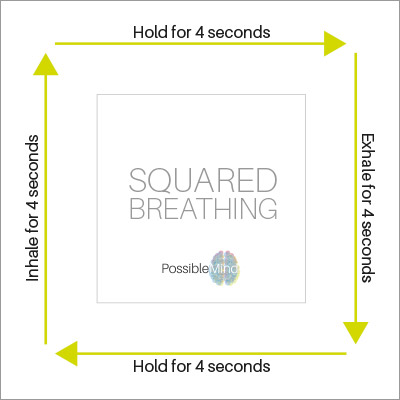We all know that Special Forces soldiers are very tough, both physically and mentally, and can endure a great deal more suffering than most of us. But would you like to learn a technique which Navy SEALs use to help with there pain resistance? If you are anything like me the answer would definitely be YES. And that is what I thought when I saw this months issue of Wonderpedia . Inside was just one paragraph which read:
How do I Increase my Pain Resistance?
Navy SEALs use the 4-4-4 technique. For four minutes they alternate between breathing in for four seconds, then breathing out for four seconds. Doing so helps them concentrate on their aim, conquer their fears and weakens their perception of pain.
My initial response when I saw the paragraph was that is quite interesting, but I would like to know more. I spoke to couple of people about the 4-4-4 technique and they both said stated that they had heard of it but know it as ‘Squared Breathing’ or ‘Boxed Breathing’.
From here I started me research. The first point I would like to raise is this; I am not a Navy SEALs and never will be but I can easily assume there is alot more to doing their job than just this breathing exercise, however if it can help, even in a little way, in the most dire of situations it is worth us exploring further to help us in our daily life situations.
The first thing I found was that ‘Squared Breathing’ is slightly different from the 4-4-4 which the Navy SEALs use for Pain Management:
- Take a deep breath, breathing in for four seconds.
- Hold your breath for four seconds.
- Slowly exhale for four seconds.
- Do nothing for four seconds and then repeat the process as many times as you need until you calm down.
Source – ehow.com
You may notice that there is no mention of doing it for 4 minutes. However I am sure there is not harm in doing the exercise for 4 minutes as long as you are listening to what your body is telling you. I found another slight variation of the ‘Squared Breathing’ which is at part 4 of the above instructions we are told to do nothing for 4 seconds where in others they suggest us to hold our breath for four seconds (see image below). My suggestion is to do what is best for you by listening to your body and intuition.

One of the benefits of these techniques is best explained by Santa Clara University:
Deep breathing regulates the physiological fight/flight response that we experience when we are stressed.
Source – www.scu.edu
What this says to me is that this breathing exercise gives us extra space to choose our best response to any stimuli as this picture below demonstrates:

This can be powerful in so many ways because having space to make the correct decision can save time, help manage pain, increase concentration and allow you to be in the moment.
With regard to pain we have known for sometime that deep breathing, which ever technique, is helpful for controlling pain and is clearly demonstrated through the breathing exercises expectant mothers are given during Child Birth. An article titled ‘How breathing deeply can reduce pain‘ shares some interesting research that a healthy human breaths between 12 -18 times a minute but if we, safely, reduce this down to 6 per minute it can really help with managing pain. Some quick calculations shows that the ‘Squared Breathing’ brings our breath down to around 3.75 to 5 per minute and the 4-4-4 technique works out at 7.5 breaths per minute. Both being much closer to the six per minute than our standard breathing. The research study concluded:
One theory is that slow breathing reduces pain by having a direct effect on the sympathetic nervous system – fibres in the central nervous system which help to control blood flow and skin temperature.
Source: Daily Mail Online
We now know the techniques and why it is good for us the next part I really want to know about both the 4-4-4 and the ‘Squared Breathing’ is where does it come from?
The answer is more difficult to find than the techniques. The techniques can be found everywhere, but is origins took a little more time to find. No surprise where it was founded, the East and in particular India.
Pranayama Yoga has a similar technique called Sama Vritti which broken down means ‘Sama = even, smooth, flat, equal or same’ and ‘Vritti = fluctuations or modifications’ which I can safely assume is where the terminology ‘Squared Breathing’ developed from.
The Sama Vritti technique
- Come to sit in a comfortable, cross-legged position such as easy pose, taking padding under your seat as necessary.
- Close your eyes and begin to notice your natural breath, not changing anything at first.
- Begin a slow count to four as you inhale. Then also count to four as you exhale. The exercise is to match the length of your inhale and exhale.
- You may experiment with changing the number you count to, just make sure your inhale and exhale stay the same length.
- Continue breathing this way for several minutes.
Source – yoga.about.com
Further discovery disclosed that Pranayama in Sanskrit means:
“extension of the prāṇa or breath” or “extension of the life force”
Source – wikipedia
Once again eastern philosophy is finding its way in our western life. The Synergy between both Eastern Philosophy and Science Based Medicine are getting closer and closer as science proves what the eastern mystics instinctual knew hundreds of years ago. Examples being pain clinics now use Acupuncture to help with pain and the research is just growing and growing in to the benefits of meditation and breathing exercises.
This morning during the first part of my meditation I tried the ‘Squared Breathing’ and found it really did help increase my concentration for the second part of my meditation resulting in one of the best practices I have had in while.
To conclude this technique used by the Navy SEALs is becoming very mainstream for self help and has been around for years. This fact alone must demonstrate how effective and helpful it in helping day to day with stressful and painful situations. It may be worth experimenting with a variety of breathing exercises to find the best technique for you to get the highest pain resistance, but based on the research slowing our breathing really does help manage pain.
If you have used this technique to help with your pain or life, If you are an military personnel who has used 4-4-4 to support you in your role or if you would just like to get in touch to share your thoughts I would love to hear from you.
N.B. : Earlier in this post I mentioned about research bringing Eastern and Western views together. If you would like to find out more about some of the research examples please check out my new book – Your Body, Only Better.







Discussion2 Comments
Russian Special Forces way ahead in this regard. Systema/Sambo is the name of their art. Absolute complete relaxation. Check Vladimir Vasiliev.
http://www.russianmartialart.com/index.php
Example- breathing through the pores for pain relief. This is also a western occult method. ( Franz Bardon- Initiation into Hermetics)
Project Renaissance
http://www.winwenger.com/part28.htm
Glad you put in a warning about breathing. It must not be forced. I became unwell by forcing things. I now let my body find its own rhythm in most things. Systema above has different breathing ratios for different fighting and life situations.
Thank you for your comment. You raise very interesting points and I appreciate the links.